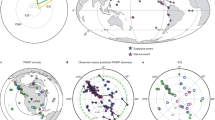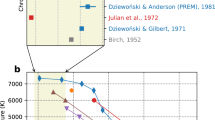Abstract
The seismological properties of the Earth's inner core have become of particular interest as we understand more about its composition and thermal state1,2. Observations of anisotropy and velocity heterogeneity in the inner core are beginning to reveal how it has grown and whether it convects3,4. The attenuation of seismic waves in the inner core is strong, and studies of seismic body waves5,6 have found that this high attenuation is consistent with either scattering or intrinsic attenuation5. The outermost portion of the inner core has been inferred to possess layering and to be less anisotropic than at greater depths7,8,9,10. Here we present observations of seismic waves scattered in the inner core which follow the expected arrival time of the body-wave reflection from the inner-core boundary. The amplitude of these scattered waves can be explained by stiffness variations of 1.2% with a scale length of 2 kilometres across the outermost 300 km of the inner core. These variations might be caused by variations in composition, by pods of partial melt in a mostly solid matrix or by variations in the orientation or strength of seismic anisotropy.
This is a preview of subscription content, access via your institution
Access options
Subscribe to this journal
Receive 51 print issues and online access
$199.00 per year
only $3.90 per issue
Buy this article
- Purchase on Springer Link
- Instant access to full article PDF
Prices may be subject to local taxes which are calculated during checkout




Similar content being viewed by others
References
Anderson, O. L. Mineral physics of iron and of the core. Rev. Geophys. 33, 429–441 (1995).
Boehler, R. Temperatures in the Earth's core from melting point measurements of iron at high static pressures. Nature 363, 534– 536 (1993).
Tanaka, S. & Hamaguchi, H. Degree one heterogeneity and hemispherical variation in anisotropy in the inner core from PKP(BC) - PKP(DF) times. J. Geophys. Res. 102, 2925–2938 (1997).
Romanowicz, B., Li, X. D. & Durek, J. Anisotropy in the inner core—could it be due to low-order convection. Science 274, 963– 966 (1996).
Cormier, V. F., Xu, L. & Choy, G. L. Seismic attenuation in the inner core: Viscoelastic or stratigraphic? Geophys. Res. Lett. 21, 4019–4022 (1998).
Bhattacharyya, J., Shearer, P. M. & Masters, T. G. Inner core attenuation from short period PKP(BC) versus PKP(DF) waveforms. Geophys. J. Int. 114, 1–11 (1993).
Song, X. & Helmberger, D. V. Seismic evidence for an inner core transition zone. Science 282, 924– 927 (1998).
Souriau, A. & Souriau, M. Ellipticity and density at the inner core boundary from subcritical PKiKP and PcP data. Geophys. J. Int. 98, 39–54 ( 1989).
Shearer, P. M. Constraints on inner core anisotropy from PKP(DF) travel times. J. Geophys. Res. 99, 19647–19659 (1994).
Song, X. & Helmberger, D. V. Depth dependence of anisotropy of Earth's inner core. J. Geophys. Res. 100, 9805–9816 (1995).
Capon, J. Analysis of Rayleigh-wave multipath at LASA. Bull. Seismol. Soc. Am. 60, 1701–1731 ( 1970).
Green, P. E., Frosch, R. A. & Romney, C. F. Principles of an experimental large aperture seismic array (LASA). Proc. IEEE 53, 1821– 1833 (1965).
Engdahl, E. R., Flinn, E. A. & Romney, C. F. Seismic waves reflected from the Earth's inner core. Nature 228, 852–853 (1970).
Shearer, P. M. & Masters, T. G. The density and shear velocity contrast at the inner core boundary. Geophys. J. Int. 102, 491–498 ( 1990).
Buchbinder, G. G. R., Wright, C. & Poupinet, G. Observations of PKiKP at distances less than 110°. Bull. Seismol. Soc. Am. 63, 1699– 1707 (1973).
Wu, R. -S. & Aki, K. Elastic wave scattering by a random medium and the small-scale inhomogeneities in the lithosphere. J. Geophys. Res. 90, 10261–10273 (1985).
Aki, K. & Richards, P. G. Quantitative Seismology: Theory and Methods Vols 1 and 2 (Freeman, San Francisco, 1980 ).
Dziewonski, A. M. & Anderson, D. L. Preliminary reference Earth model. Phys. Earth Planet Inter. 25 , 297–356 (1981).
Widmer, R., Masters, T. G. & Gilbert, F. Spherically-symmetric attenuation within the Earth from normal mode data. Geophys. J. Int. 104, 541–553 (1991).
Mao, H.-k. et al. Elasticity and rheology of iron above 220 GPa and the nature of the Earth's inner core. Nature 396, 741 –732 (1998).
Mao, H.-k. et al. Correction—Elasticity and rheology of iron above 220 GPa and the nature of the Earth's inner core. Nature 399, 280 (1999).
Stixrude, L. & Cohen, R. E. High-pressure elasticity of iron and the anisotropy of the Earth's core. Science 267 , 1972–1975 (1995).
Jephcoat, A. & Olson, P. Is the inner core of the Earth pure iron? Nature 325, 332–335 (1987).
Jeanloz, R. The nature of the Earth's core. Annu. Rev. Earth Planet. Sci. 18, 357–386 (1990).
Song, X. D. & Richards, P. G. Seismological evidence for differential rotation of the Earth's inner core. Nature 382, 221–224 (1996).
Acknowledgements
We thank the Albuquerque Seismological Laboratory and specifically R. Woodward and H. Bolton for access to LASA data; we also thank P. Shearer, F. Xu, S. Persh and J. Green for comments on the manuscript. L. Knopoff generalized the formula for scattering to non-Poisson solids.
Author information
Authors and Affiliations
Corresponding author
Rights and permissions
About this article
Cite this article
Vidale, J., Earle, P. Fine-scale heterogeneity in the Earth's inner core. Nature 404, 273–275 (2000). https://doi.org/10.1038/35005059
Received:
Accepted:
Issue Date:
DOI: https://doi.org/10.1038/35005059
This article is cited by
-
Multidecadal variation of the Earth’s inner-core rotation
Nature Geoscience (2023)
-
Enhanced inner core fine-scale heterogeneity towards Earth’s centre
Nature (2023)
-
Small-scale layered structures at the inner core boundary
Nature Communications (2023)
-
Seismological evidence for a localized mushy zone at the Earth’s inner core boundary
Nature Communications (2017)
-
Earth’s solid inner core: Seismic implications of freezing and melting
Journal of Earth Science (2013)
Comments
By submitting a comment you agree to abide by our Terms and Community Guidelines. If you find something abusive or that does not comply with our terms or guidelines please flag it as inappropriate.



